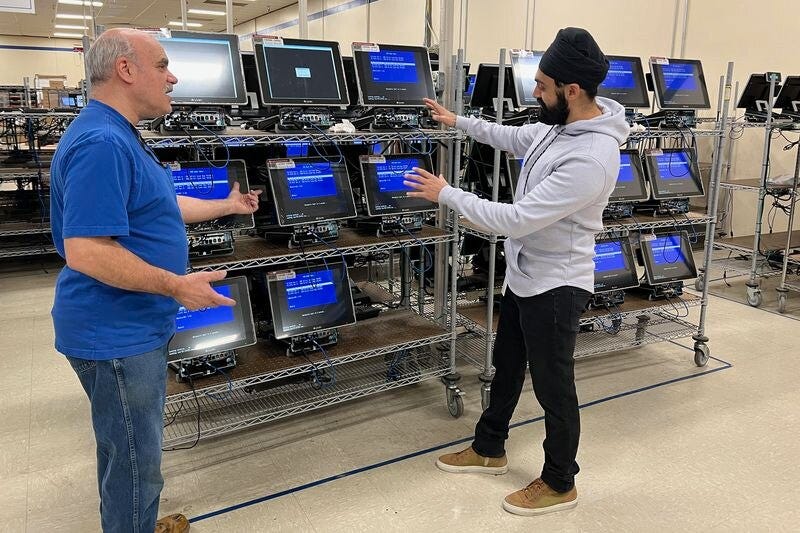An Interview With Martita Mestey
Be simple. Complicated stories, menus and products rarely work. Start with something uncomplicated that solves a problem or need, then grow beyond it.
As a part of our series called “5 Things You Need To Create a Successful Food or Beverage Brand”, I had the pleasure of interviewing Savneet Singh.
Savneet Singh is the President & CEO of PAR Technology Corp., and President of ParTech, Inc.
Thank you so much for doing this with us! Before we dive in, our readers would love to learn a bit more about you. Can you tell us a bit about your “childhood backstory”?
I grew up in upstate New York and had a fairly typical childhood but with a unique set of parents. My father pushed me to be a leader, instilling in my siblings and me that we should strive to be the best we can be because we only live once. Meanwhile, my mother, who comes from a family of social activists, showed me what servant leadership looks like.
My parents taught me that it wasn’t enough to simply participate — I had to try to accomplish something exceptional. My father was so passionate about this idea that he sent me to a tennis academy when I was only 13 because I was good at tennis. He even encouraged me to drop out of high school to pursue a professional athletic career. The idea wasn’t to drop out but to encourage us to give every ounce and not worry about external expectations.
Both perspectives shaped my upbringing and influenced my leadership style. While my father pushed me to pursue my dreams, my mother had a more traditional view of success — a stable job, a happy marriage and children. I combined both viewpoints while pursuing a career in a field I’m passionate about. And I have often referred to the lessons I learned in childhood as guides to help me create a stable, prosperous life where I can coach and lead others.
What are the most common mistakes you have seen people make when they start a food or beverage line? What can be done to avoid those errors?
One of the most common mistakes I’m seeing now is business owners relying on business approaches that worked for previous generations instead of exploring and adopting newer strategies. Millennials are now the largest adult generation, so new businesses in the food and beverage industry should focus on mastering social media, growing their online presence and investing in the right technology.
It’s not enough to offer great food and customer service anymore; customers expect loyalty apps, online ordering and food delivery services. The pandemic created unbelievable pressure for restaurants to become software companies. It accelerated technological innovation in the food and beverage industry, leaving many restaurants to navigate this tremendous digital disruption without much guidance.
In such a fiercely competitive industry, businesses can stay relevant by partnering with and counting on a dependable technology company to manage the digital aspect of their operations. This way, restaurant owners can concentrate on what they do best: serving delicious food. At PAR, we firmly believe that restaurants can offer fantastic guest experiences and meet the demands of today’s digital consumers. The key is to remember that your digital footprint is as significant as your physical footprint.
Let’s imagine that someone reading this interview has an idea for a product that they would like to produce. What are the first few steps that you would recommend that they take?
Get some data! Don’t live off of a hunch; start selling, figure out who likes and loves your product then quickly determine if that market is worth your time. There are lots of good ideas but very few scalable ideas. So work swiftly to figure out how big your actual market is and how to attract natural believers. Then iterate constantly!
Another crucial tip to remember: find and reward talented people. By setting the bar high for recruitment, you’ll attract the type of employee who’ll help you reach your goals, leading to more business revenue for you and better compensation for them. It’s often the who that matters more than the what. Sometimes we get lost in the weeds of execution, process and hierarchy, but the incredible talent makes it happen.
Many people have good ideas all the time. But some people seem to struggle in taking a good idea and translating it into an actual business. How would you encourage someone to overcome this hurdle?
Starting a business can feel very overwhelming, especially in today’s economy. But there’s always a market for great ideas — you just need to take action, even if you start with small steps. Building and maintaining momentum takes you much farther than you might imagine.
Validate your idea and anticipate potential issues by researching your target market, competition and industry trends. Make a budget and then create mechanisms to force you to commit or de-commit (e.g., if we hit $100,000 in sales, I’ll quit my job).
The most important part, though, is believing you can do it. If you’re holding on to doubt, you’re better off being a financial advisor. 😉
There are many invention development consultants. Would you recommend that a person with a new idea hire such a consultant, or should they try to strike out on their own?
I’m personally a believer in self-reliance. I’d build an MVP of your product, get it into the hands of customers or potential customers and grow from there. Customers are far better consultants than any Harvard MBA.
What are your thoughts about bootstrapping vs. looking for venture capital? What is the best way to decide if you should do either one?
It entirely depends on the business. Certain businesses can support themselves from their founder’s bank account or company cash flow. Others need lots of money to get off the ground (think big capital investments or large enterprise software products). There are certainly pros and cons to each, but for me, it boils down to knowing:
- Is this a business that can fund itself?
- Is this business big enough to support venture capital?
Taking on capital can supercharge your business. Just remember investors get paid back first, and you now have a partner you must work with at the table.

Here is the main question of our discussion. What are your “5 Things You Need To Create a Successful Food or Beverage Brand” and why?
- Consider digital solutions, strategies, or innovations. We’ve seen the success of things like MrBeast Burger that have shown us how significant a digital presence can be to brand building. Not everyone — or most — won’t have anything like MrBeast Burger. But everyone can create a digital experience that elevates their brand in the minds of consumers.
- Be differentiated. Consumers are flooded with offline and online choices. Find a way to stand out, whether it’s the ingredients in your product, your company’s vision/culture or your brand story. It helps you stand out and gives your team far more to work with regarding marketing and recruiting.
- Be simple. Complicated stories, menus and products rarely work. Start with something uncomplicated that solves a problem or need, then grow beyond it.
- Be bold. Doing so will make your brand memorable and reach a broader audience.
- Create a unified tech stack. By investing in a unified tech stack, you will be able to deliver a seamless customer experience.
Can you share your ideas about how to create a product that people really love and are ‘crazy about’?
Creating a product that people will love is incredibly challenging and rewarding. Your journey starts with defining your audience. Identifying your target group makes it easier to research their needs, pinpoint trending products and request feedback on product ideas. Today’s consumers want to feel like their brands understand them, so establish that connection with them from the start.
Equally critical? Investing in the right technology for your product and company. Millennials and Gen Z are digital natives driving the next step in our product evolution. Because the COVID-19 pandemic accelerated the digitalization of most industries, technological innovation isn’t a “nice to have” but a requirement. Creating a product with digital convenience in mind will generate further interest.
Don’t be scared to push the line of ordinary. No one remembers the ad, packaging or story that’s down the middle.
Ok. We are nearly done. Here are our final questions. How have you used your success to make the world a better place?
As PAR CEO, I want to invest in our workforce culture. Our employees must have the freedom and ownership to grow and explore their careers. We back that up with a merit-based compensation system rewarding our employees for their hard work. Our employees deliver incredible value, and we want to show appreciation. The result has been very high eNPS scores, a strong culture of ambition and many internal promotions.
Alongside that, we try and live our values. One of our values is #WinningTogether. It’s the belief that winning at PAR means our customers, employees, shareholders and community succeed. We’re dedicated to positively impacting our community by establishing a solid foundation over time. We understand that our success requires our teams to spend time away from their families and communities to deliver for PAR. Therefore, we are committed to giving back some of that value.
Outside of that, I’ve never been afraid to take a stand on things I believe in. I don’t believe politics has a place in the work environment. But outside of work, I stay active in causes I’m passionate about. I’ve always felt that most of my success has been circumstantial; I was born in the right country within the right family to do what I’ve done. I think a lot about how to effectuate that outcome for others.
You are an inspiration to a great many people. If you could inspire a movement that would bring the most amount of good to the most amount of people, what would that be? You never know what your idea can trigger.
There are so many movements I’d love to inspire in others!
I propose implementing mandatory military or social service for all citizens to bring Americans closer together. This idea would provide shared experiences that can unite us as one country. Working with people from diverse backgrounds can help us see each other as human beings. This experience could reduce insecurities and improve our ability to work together in all aspects of life, including politics and daily interactions.
Thank you for these fantastic insights. We greatly appreciate the time you spent on this.
Savneet Singh Of PAR Technology On 5 Things You Need To Create a Successful Food or Beverage Brand was originally published in Authority Magazine on Medium, where people are continuing the conversation by highlighting and responding to this story.


